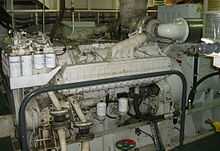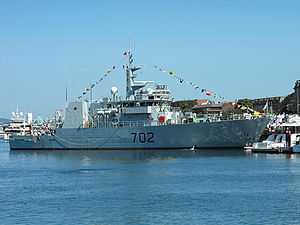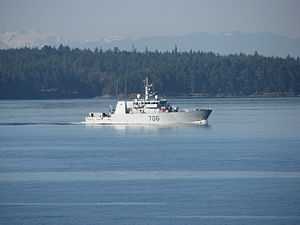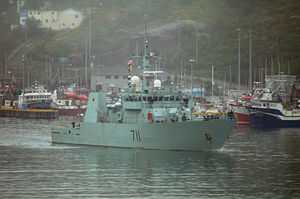Kingston-class coastal defence vessel
 HMCS Brandon (MM 710) | |
| Class overview | |
|---|---|
| Name: | Kingston class |
| Builders: | Halifax Shipyards Ltd., Halifax |
| Operators: |
|
| Preceded by: | Anticosti class |
| In commission: | 21 September 1996–present |
| Completed: | 12 |
| Active: | 7 [1] |
| General characteristics | |
| Type: | Coastal defence vessel |
| Displacement: | 970 t (970.0 t) |
| Length: | 55.3 m (181.43 ft) |
| Beam: | 11.3 m (37.07 ft) |
| Draught: | 3.4 m (11.15 ft) |
| Propulsion: | 2 × Jeumont DC electric motors 4 × 600 VAC Wärtsilä SACM V12 diesel alternators 2 × Z drive azimuth thrusters |
| Speed: | 15 kn (27.78 km/h) |
| Range: | 5,000 nmi (9,260.00 km) |
| Complement: | 31 to 47 |
| Sensors and processing systems: | Kelvin Hughes navigation radar (I-band) Kelvin Hughes 6000 surface search radar (E-F band) Global Positioning System Towed high-frequency sidescan sonar Remote-control Mine Hunting System (RMHS) Magnetic degaussing system |
| Armament: | 1 × Bofors 40 mm 60 Mk 5C cannon 2 × M2 Machine Guns |
The Kingston class consists of 12 coastal defence vessels operated by the Royal Canadian Navy.
The class is the name for the Maritime Coastal Defence Vessel Project (MCDV). These multi-role vessels were built and launched from the mid- to late-1990s and are crewed entirely by members of the Naval Reserve, with the exception of two regular-force technicians per crew.[2]
Their main missions are coastal surveillance, sovereignty patrol, route survey, and training. They were designed with a minesweeping role in mind and are consequently classified as mechanical minesweepers (MM); however, this role has diminished as a result of the evolving nature of mine warfare. The possibility of acquiring the gear necessary to undertake a more appropriate mine-hunting role continues to be examined.
Design
The Kingston-class patrol vessels were conceived to advance the use of commercial off-the-shelf (COTS) equipment and construction techniques in a ship designed to military specifications.
While the Z-drive thrusters make the Kingston-class vessels extremely manoeuvrable (able to turn within their own shiplength) and the engines are quite powerful and fuel-efficient, the hull shape, with a blunt stern and "hard" chine designed for minesweeping, prevents the ship from achieving a "sprint" speed and the patrol vessels of other nations are considerably faster. However, the Kingstons' top speed is faster than that of most mine warfare vessels and is comparable to most large non-naval seagoing vessels.
The hull is a longitudinally framed structure and has been designed to minimize steel weight. The construction involved initial production of partially outfitted steel modules which were made into sub-assemblies and then integrated into the ship. The decks were assembled upside down with pre-outfitting of the underside of the deck prior to installation on the ship. In contrast to many modern mine warfare vessels, which often have hulls made of non-magnetic glass-reinforced plastic or similar material, the Kingston class have conventional steel hulls. The vessels are, however, equipped with a magnetic degaussing system that allows the ship's magnetic signature to be manipulated in three dimensions to minimize vulnerability to magnetic mines.
Modular payload
Kingston-class vessels are designed to carry up to three 20-foot (6.1 m) ISO containers with power hookups on the open deck aft in order to embark mission-specific payloads.[3] As of 2009, the available modules included:[3]
- 2 × Indal Technologies AN/SLQ 38 deep mechanical minesweeping systems
- 4 × MDA Ltd. AN/SQS 511 heavy-weight high-definition route survey systems
- 1 × ISE Ltd. Trailblazer 25 bottom object inspection vehicle
- 1 × ISE Ltd. HYSUB 50 deep seabed intervention system
- 2 × Fullerton and Sherwood Ltd. 6-man, 2-compartment containerized diving systems
- 6 × naval engineered 6-person accommodation modules
- 1 × MDA Ltd. Interim Remote Minehunting and Disposal System
Weapons
The ships are equipped with a Bofors 40 mm Model 60 Mk 5C rapid fire gun, and two 12.7 mm (.50 cal) machine guns.[2][4] The Bofors gun is mounted on the forecastle deck and the arc of fire extends forwards by ±120°. The machine guns are mounted on either side at the front of the bridge deck. In a depressed position each machine gun fires in an 118° arc.

The main armament is a Second World War Bofors design that is manually loaded and lacks modern targeting capability.[5]
In October 2006, Maritime Command experimented with mounting a remote controlled heavy machine gun station, the OTO Melara 12.7 mm RCHMG, in place of the 40 mm Bofors cannon aboard HMCS Summerside.[6][7][8]
Sensors
The navigation equipment includes a Sperry Marine Bridge Master E I-band navigation radar and a Global Positioning System. The surface search radar is the E to F-band Sperry Marine Bridge Master E. A towed high-frequency sidescan sonar can be fitted for bottom mapping and route surveys.
Propulsion

The ship is equipped with four main Wärtsilä UD 23V12 diesel engines which are coupled to four alternators (600 V AC). Two Jeumont electric motors (±740 V DC) provide power to the two LIPS Z-drive azimuth thrusters which are fitted with fixed-pitch reversing propellers. The propulsion system provides 15 knots (28 km/h) maximum continuous speed. The range at the economical cruising speed of 9 knots (17 km/h) using two engines is 5,000 nautical miles (9,000 km) with a 20% margin in tank capacity. Mechanical minesweeping is carried out at 8 knots (15 km/h). The crash stop length is five ship lengths from a speed of 15 knots (28 km/h).
Deployment and operations
The ships are evenly distributed between the east and west coasts.[3]
One vessel on each coast is maintained for rapid deployment: this responsibility is rotated amongst the ships.[3]
Future of the class
The Royal Canadian Navy is discarding a $100-million mid-life refit plan for the twelve vessels in this class.[9] Instead, MCDVs will be replaced by new vessels to enter service in 2020. It had been intended to retain the "mid-lifed" vessels through 2045–2055; however, the RCN has concluded that the money would be better spent in acquiring a new platform. The RCN review listed low speed and small size as reasons for the MCDV being inadequate for patrol duties (both are factors of the original specification). Notwithstanding the success of the ships in their deployment, critics suggest that patrol and training were tacked onto the mine-countermeasures role and that the platform lacks serious armament for a sovereignty enforcement role.[9]
On May 13, 2010, it was announced that six of the twelve MCDVs would be placed in extended readiness due to lack of funds and the inability of the naval reserve to provide sufficient personnel to man the ships.[10] On May 14 however that order was rescinded.[11]
In October 2011, L-3 MAPPS was awarded a contract to supply degaussing systems for the Kingston-class ships. The advanced degaussing systems were to be delivered and supported locally in collaboration with SAM Electronics.[12]
In November 2012 MacDonald, Dettwiler and Associates was awarded a two-year $13.4 million contract to repair and upgrade the deployable sonar systems.[13]
Five of the class have been removed from service in an effort to cut costs.[1]
Ships in class
There are twelve Kingston-class ships in Canadian service:
HMCS Kingston (MM 700)
.jpg)
- Builders:
 Halifax Shipyards Ltd., Halifax
Halifax Shipyards Ltd., Halifax - Laid down: 12 December 1994
- Launched: 12 August 1995
- Operator: Royal Canadian Navy
- Commissioned: 21 September 1996
- Status:
- Modifications:
- Operations:
HMCS Glace Bay (MM 701)
- Builders:
 Halifax Shipyards Ltd., Halifax
Halifax Shipyards Ltd., Halifax - Laid down: 28 April 1995
- Launched: 22 January 1996
- Operator: Royal Canadian Navy
- Commissioned: 26 October 1996
- Status:
- Modifications:Oto Melara 12.7 mm RWS
- Operations:
HMCS Nanaimo (MM 702)

- Builders:
 Halifax Shipyards Ltd., Halifax
Halifax Shipyards Ltd., Halifax - Laid down: 11 August 1995
- Launched: 17 May 1996
- Operator: Royal Canadian Navy
- Commissioned: 10 May 1997
- Status:
- Modifications:
- Operations:
HMCS Edmonton (MM 703)

- Builders:
 Halifax Shipyards Ltd., Halifax
Halifax Shipyards Ltd., Halifax - Laid down: 8 December 1995
- Launched: 31 October 1996
- Operator: Royal Canadian Navy
- Commissioned: 21 June 1997
- Status:
- Modifications:
- Operations:
HMCS Shawinigan (MM 704)
NCSM_Shawinigan.jpg)
- Builders:
 Halifax Shipyards Ltd., Halifax
Halifax Shipyards Ltd., Halifax - Laid down: 26 April 1996
- Launched: 15 November 1996
- Operator: Royal Canadian Navy
- Commissioned: 14 June 1997
- Status:
- Modifications:
- Operations:
HMCS Whitehorse (MM 705)
- Builders:
 Halifax Shipyards Ltd., Halifax
Halifax Shipyards Ltd., Halifax - Laid down: 26 July 1996
- Launched: 24 February 1997
- Operator: Royal Canadian Navy
- Commissioned: 17 April 1998
- Status:
- Modifications:
- Operations:
HMCS Yellowknife (MM 706)

- Builders:
 Halifax Shipyards Ltd., Halifax
Halifax Shipyards Ltd., Halifax - Laid down: 7 November 1996
- Launched: 5 June 1997
- Operator: Royal Canadian Navy
- Commissioned: 18 April 1998
- Status:
- Modifications:
- Operations:
HMCS Goose Bay (MM 707)

- Builders:
 Halifax Shipyards Ltd., Halifax
Halifax Shipyards Ltd., Halifax - Laid down: 22 February 1997
- Launched: 4 September 1997
- Operator: Royal Canadian Navy
- Commissioned: 26 July 1998
- Status:
- Modifications:
- Operations:
HMCS Moncton (MM 708)
- Builders:
 Halifax Shipyards Ltd., Halifax
Halifax Shipyards Ltd., Halifax - Laid down: 31 May 1997
- Launched: 5 December 1997
- Operator: Royal Canadian Navy
- Commissioned: 12 July 1998
- Status:
- Modifications:
- Operations:
HMCS Saskatoon (MM 709)

- Builders:
 Halifax Shipyards Ltd., Halifax
Halifax Shipyards Ltd., Halifax - Laid down: 5 September 1997
- Launched: 30 March 1998
- Operator: Royal Canadian Navy
- Commissioned: 5 December 1998
- Status:
- Modifications:
- Operations:
HMCS Brandon (MM 710)

- Builders:
 Halifax Shipyards Ltd., Halifax
Halifax Shipyards Ltd., Halifax - Laid down:
- Launched:
- Operator: Royal Canadian Navy
- Commissioned: 5 June 1999
- Status:
- Modifications:
- Operations:
HMCS Summerside (MM 711)

- Builders:
 Halifax Shipyards Ltd., Halifax
Halifax Shipyards Ltd., Halifax - Laid down:
- Launched: 26 Sept. 1998
- Operator: Royal Canadian Navy
- Commissioned: 18 July 1999
- Status:
- Modifications:
- Operations:
See also
Other similar class coastal defence vessels:
- Visby-class corvette, of the Royal Swedish Navy
- Baynunah-class corvette, of the United Arab Emirates Navy
- Nornen-class patrol vessel, of the Royal Norwegian Navy
Other Royal Canadian Navy Vessels:
- Halifax class frigate (hull designation FFH)
References
- ↑ 1.0 1.1 "Two more navy defence ships taken out of service". CTV News. 3 December 2013. Retrieved 15 March 2014.
- ↑ 2.0 2.1 Stephen Priestley. "The Kingston Class: Mid-Life or Move Over for the MCDV?". Canadian American Strategic Review. Archived from the original on August 10, 2007. Retrieved 2007-08-31.
- ↑ 3.0 3.1 3.2 3.3 Saunders, Stephen (ed.) (2008). Jane's Fighting Ships 2008–2009. Jane's Fighting Ships (111th ed.). Surrey: Jane's Information Group. p. 95. ISBN 978-0-7106-2845-9. OCLC 225431774.
- ↑ Stephen Priestley (June 2006). "The Kingston Class: 'Mid-Life' or Move Over for the MCDV?". Canadian American Strategic Review. Retrieved 2012-01-09.
Among MCDV inadequacies, armament is listed as the major limitation for sovereignty patrol duties. Kingston Class are armed with twin 12.7 mm M2HB machine guns on either side of the bridge but the main armament is a 40 mm L/60 Bofors. This gun is a museum piece dating back to 1944. Even as training weapons, the Bofors is of dubious value – they were just on hand and lowered costs.
mirror - ↑ Stephen Priestley. "The Kingston Class: 'Mid-Life' or Move Over for the MCDV? Reviewing Navy Plans for the Future of the MCDVs [Part 2]". Canadian American Strategic Review. Archived from the original on August 7, 2007. Retrieved 2007-08-31.
- ↑ "Background — CF Remote Control Heavy Machine Gun Project". Canadian American Strategic Review. Archived from the original on May 25, 2007. Retrieved 2007-08-31.
- ↑ Sublieutenant Ryan Bell (November 27, 2006). "Summerside trials weapons system" (PDF). Trident News. Archived from the original (PDF) on September 29, 2007. Retrieved 2007-08-31.
- ↑ 9.0 9.1 Stephen Priestley. "The Kingston Class: 'Mid-Life' or Move Over for the MCDV? Reviewing Navy Plans for the Future of the MCDVs [Part 1]". Canadian American Strategic Review. Archived from the original on August 7, 2007. Retrieved 2007-08-31.
- ↑ http://ca.news.yahoo.com/s/cbc/100513/topstories/canada_novascotia_ns_navy_coastal_ships
- ↑ "Order to cut navy's coastal vessels rescinded". CBC News. 14 May 2010.
- ↑ "Royal Canadian Navy KINGSTON-Class Vessels to be Equipped with L-3 MAPPS Degaussing Systems". naval-technology.com. 7 October 2011. Retrieved 15 March 2014.
- ↑ "Sonar On The Royal Canadian Navy’s MCDV’s To Be Upgraded". Ottawa Citizen. 2 November 2012. Retrieved 15 March 2014.
External links
| Wikimedia Commons has media related to Kingston class minesweepers. |
| ||||||||||